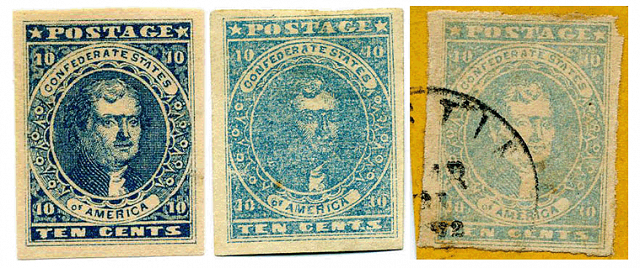
Left to right: CSA 2-H, Hoyer & Ludwig, CSA 2-P, Paterson, CSA 2-Y, Stone Y
Catalog Numbers are from the Confederate States of America Catalog and Handbook of Stamps and Postal History
The 10¢ blue lithograph is in reality three distinctive stamps, three designs and at least two different contractors.The stamp's central motif is a portrait of Thomas Jefferson, designed by Charles Ludwig of Hoyer & Ludwig, Richmond, Virginia. Both Hoyer & Ludwig and J. T. Paterson & Co. of Augusta, Georgia, printed this design. The portrait of Thomas Jefferson used on both the Hoyer & Ludwig print and the Paterson print was the same portrait used on the U.S. 5-cent issue of 1851. Marks added by Paterson to the transfer stones distinguish it from the Hoyer & Ludwig prints of the same design. The most typical use was for the ten-cent rate after July 1, 1862.
Hoyer & Ludwig: The earliest recorded date of use is November 8, 1861. This was the first stone used for this issue. There were 1,400,000 stamps printed from one stone with the imprint “Lith of Hoyer & Ludwig, Richmond, Va.”. Plating completed. Sheets of two hundred, panes of one hundred, and transfer stone of fifty. The color is a uniform dark blue with clear and distinct impressions. Plating marks are also distinct and repeated. There are a couple known with private perforations. Printing estimate of 1,403,000 based on incomplete records.
J.T. Paterson & Co: Although designed by Charles Ludwig, this issue was engraved by J.T. Paterson and printed in Augusta, Georgia. The earliest recorded date of use is July 25, 1862. Unknown plate arrangement, but believed to be a sheet of two hundred, panes of one hundred, and transfer stone of fifty. Colors include light blue, dark blue, greenish blue, light milky blue, plus the rare indigo shade (all of the latter should be authenticated). Impressions are usually poor and blurred, considerably less clear than the Hoyer & Ludwig printing. Paterson printings, other than from Stone Y, are more common that the Hoyer & Ludwig printings. There are an estimated 4,918,000 Paterson printings from an unknown number of stones.
Stone Y: The earliest recorded date of use is August 25, 1862. It is thought to have been produced by J. T. Paterson & Co. as it has the same defining markings as well as some other specifically defining characteristics such as the visible "ear" (long thought to be a "flaw" at the back of the head but proved otherwise by Kevin Andersen in the 3Q 2016 issue of the Confederate Philatelist) as well as the the lighter hair "forelock." The color is typically a light milky blue or greenish blue. Impressions are poor and of blurred appearance. The designation of Stone Y dates back to the 1920s, although there is no indication of why the “Y” was chosen over another designation. Printing estimate has not been determined.